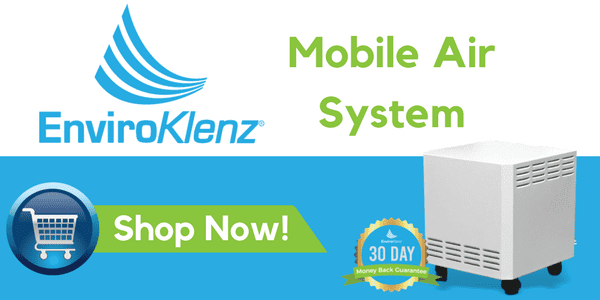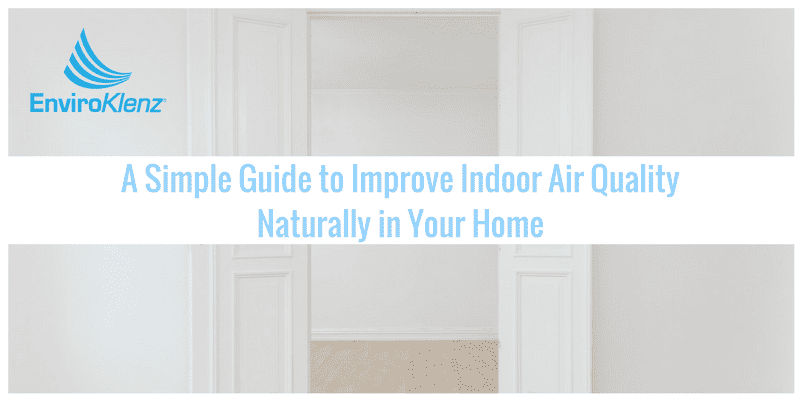The EPA found that most people spend about 90 percent of their time indoors, whether that be in the home, in an office, or in any other indoor environment. But if you are anything like me, then you can probably say with a great deal of certainty that your home is where you spend the majority of your time. Unfortunately, even though your home is your sanctuary and sacred area that you prefer to spend most of your time in, it could potentially be tainted with an excess of pollutants that can leave your home sometimes even more polluted than outdoor environments. What are you left to do when your home is potentially contaminated by indoor air pollution that is impacting the quality of your air? Finding solutions to implement in your home to improve your indoor air quality naturally could be your best and most viable option. The guide below will help you to understand the potential dangers associated with indoor air pollution and steps you can take to mitigate the pollutants in your home naturally.
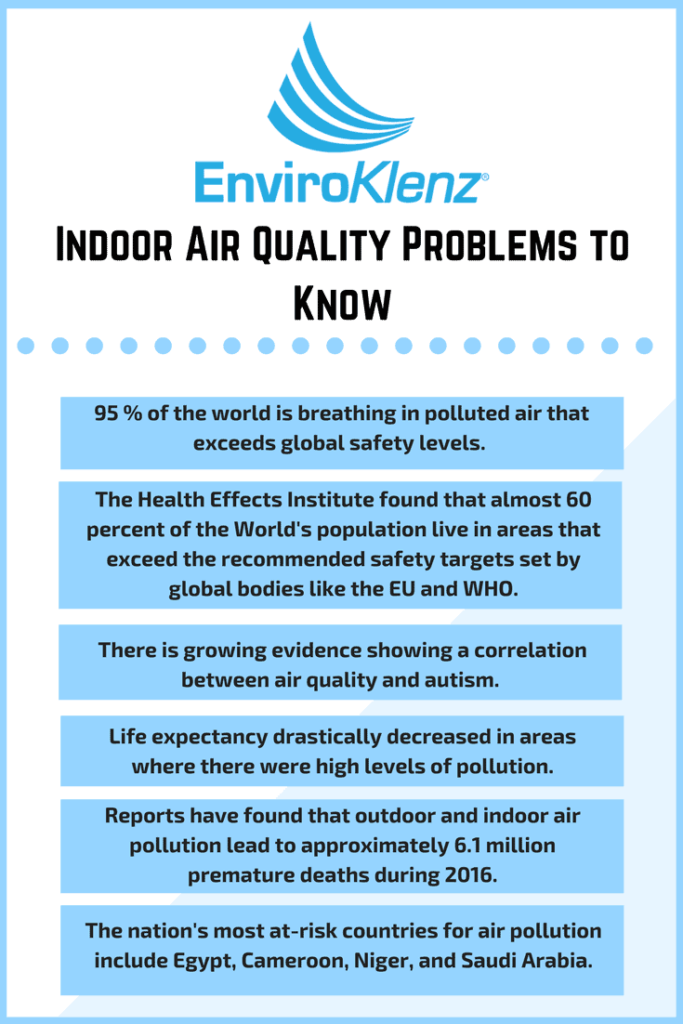 Indoor Air Quality Problems to Know
Indoor Air Quality Problems to Know
A new report looking at air quality across the globe showed that over 95 percent of the world is breathing in polluted air that exceeds global safety levels. Indoor air pollution, unlike outdoor air pollution, does not get as much attention as it rightfully deserves. Indoor air pollution according to the EPA is two to five times more polluted than outdoor air. With the increase in biomass and fossil fuels to cook and heat up homes, the high levels of smoke have increased the problem of indoor air pollution in many developing nations. But that’s not the only issue attributed to indoor air quality, some other potential issues attributed to indoor air quality include:
- The World Health Organization uses its air quality guidelines to give a gauge of how safe our air is, and how fine particulate matter in the air that we may breathe in can cause or contribute to a range of health problems like various cancers, neurological problems, infant health problems and more.
- There is growing evidence showing a correlation between air quality and autism. The evidence shows that autism spectrum behaviors may be higher in children of mothers who could potentially have been exposed to excessive pollution in the air.
- Life expectancy drastically decreased in areas where there were high levels of pollution. An estimate from China showed that more than one million people died in a single year as a result of unsafe air.
- The Health Effects Institute found that almost 60 percent of the World’s population live in areas that exceed the recommended safety targets set by global bodies like the EU and WHO.
- Reports have found that outdoor and indoor air pollution led to approximately 6.1 million premature deaths during 2016. This was largely due to conditions including stroke, heart attack, lung disease, and lung cancer.
- The nation’s most at-risk countries for air pollution include Egypt, Cameroon, Niger, and Saudi Arabia. And together, China and India are accountable for over half the world’s deaths related to air pollution.
*Reported on Care2 Cause – Study: 95 Percent of the World is Breathing Toxic Air: https://www.care2.com/causes/study-95-percent-of-the-world-is-breathing-toxic-air.html
Primary Air Pollutants Found in Home’s
The best way to defeat the enemy at hand is to know it, and thus having an idea of what pollutants are in your home and how they are getting there can help you to minimize this exposure in the future. Your lungs are one of your most “critical” organs and should be treated as such, making it vital to know what pollutants could be placing one of your “critical” organs in harm’s way.
Volatile Organic Compounds (VOCs) in Household Products
Volatile Organic Compounds (VOCs) are organic compounds that are emitted as gases from certain solids or liquids, usually, this includes a variety of chemicals that may or may not have short- or long- term health effects. In recently conducted investigations, a list of volatile organic compounds (VOCs) – specifically benzene, toluene, xylenes, and styrene – have been designated as a big contributor to indoor pollution. And what could be the potential culprit of these volatile organic compounds in homes? You may find this surprising, but certain household cleaners are big producers of this toxic air pollutant. Air fresheners, all-purpose cleaners, laundry detergent, fabric softeners, and other aerosol sprays are likely producing VOCs into the air, many releasing acetaldehyde and 1,4-dioxane into the air. So, in addition to getting that fragrant smell in your home that you love, you are also discharging these potentially hazardous pollutants into your home.
Fine Particulate Matter (PM)
Particulate matter is a complex mixture of solid and/or liquid particles suspended in air. These particulate matters come in varying sizes but the fine particulate matter smaller in size (10 diameters or smaller) is what could be potentially harmful to human health. When fine particulate matter gets inhaled, the particles can affect not only the lungs but also the heart in some cases, leading to severe health effects. Some scientific studies have even linked particulate matter exposure to a variety of health issues including eye, nose and throat irritation, respiratory disease symptoms, and even premature death in people with heart or lung disease. You may think that minimizing outdoor exposure time could be the key to eliminating or reducing your risk of inhaling fine particulate matter, however, indoor particulate matter levels have shown to be higher than outdoor levels! Sources in your home such as cooking, burning candles, using the fireplace, using unvented space heaters, and cigarette smoke are activities that could elicit an increase in PM levels in your home.
Biological Contaminants
One of the main primary air pollutants in your home are biological contaminants including bacteria, viruses, animal dander, house dust, mites, cockroaches, and pollen. Biological contaminants are produced by living things and can often be found in environments with a lot of moisture such as a bathroom, kitchen, laundry room, or even a basement. This type of an environment creates a breeding ground for bacteria, mold, mildew, and insects. For biological contaminants, good housekeeping and proper ventilation are key. Ventilation is a huge concern for the development of mold and mildew in your home as moisture will start to develop and get trapped in the area leading it to grow and spread air pollutants in the home.
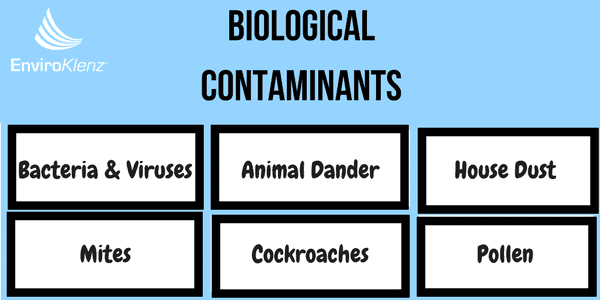
How to Test Air Quality
Knowing when in fact the quality of your air in your home has become compromised can be a little tricky. Although, in some cases, you will be able to tell a noticeable difference in your air quality based on how you feel overall such as developing symptoms such as sinus irritation and allergy-like symptoms. However, if you aren’t experiencing these symptoms but still feel like your indoor air is compromised, there are other means of seeing if your air quality is tainted by air pollutants. At home air quality test kits have become a popular means for testing air quality in your home. These tests have been shown to be 80 to 90 percent accurate in getting a precise measurement of your air quality. Also, there are air testing meters or monitors that can simply be placed in your home to acquire an accurate air quality measure. These different methods will allow you to get an accurate read of the level of air pollution accumulated in your home’s air.
Steps to Improve Air Quality in Home
Once you have determined that your home is plagued by indoor air pollutants, which most likely will be the case, you will need to have a plan of attack in eliminating and mitigating these pollutants from your home’s air. The top areas to focus on is your central air system filter, proper ventilation in your home, minimizing the use of chemical products in your air, and having an air purification system to filter out air pollutants from your home.
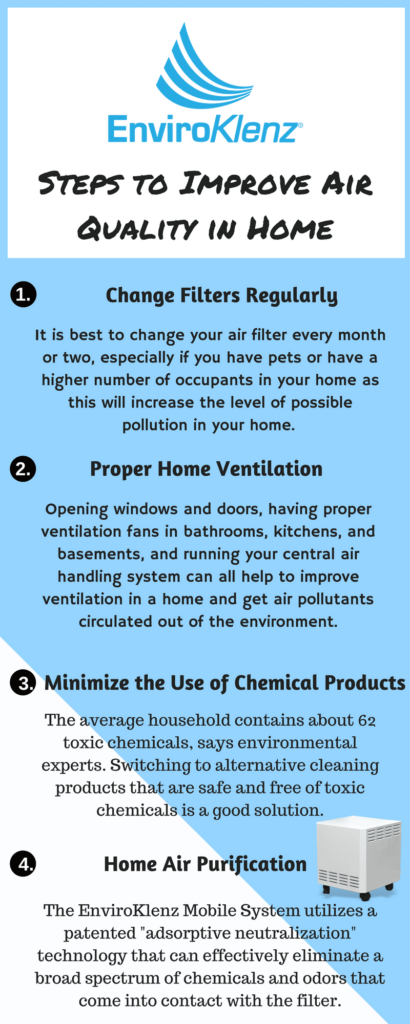 1.) Change Filters Regularly
1.) Change Filters Regularly
Air filters are used in your home to not only filter out bits of pollen and dust but also is the first line of defense against larger pieces of debris in your home’s air. As your air filter catches more and more of the natural particulate pollution of your home the mesh of the air filter will become denser, which will lead to a difficulty for air to pass through. That’s not it though, a dirty air filter can also lead to other problems such as;
- The blower fan in the HVAC system has to work harder to push air.
- A lack of air might be the result of a dirty air filter.
- The additional material on the air filter can provide a space for moisture to gather.
- Particulates can settle in ducts and on household surfaces when they’d usually be carried into the system and filtered.
It is best to change your air filter every month or two, especially if you have pets or have a higher number of occupants in your home as this will increase the level of possible pollution in your home. Depending on the type of air filter you have in your central air handling system, you may be able to get by with a couple more months before needing to change it out. The EnviroKlenz HVAC Filter uses a patented “adsorptive neutralization” technology that effectively traps and neutralizes a broad spectrum of chemicals and odors that pass through the filter. Anything from VOCs, chemical compounds, and odors will be destroyed with no re-releasing of these particulates. Due to the efficiency of this filter and its ability to break down pollutants in your home’s air, the life of the filter is extended to 6 months, making your job of changing your air filter a semi-annual task.
2.) Proper Home Ventilation
Ventilation in your home can also be another approach to lowering the amounts of indoor air pollutants circulating in your air. Without proper ventilation, in a home, the ability to filter out pollutants from the air becomes extremely hard, as well as the potential for a buildup of moisture to gather due to the poor ventilation. Recently, homes have been built to be more economically efficient to lower costs such as electricity costs. Although this is a great idea, the lack of ventilation left in these home’s make for a potential pool of pollutants collected in your home’s air.
Opening windows and doors, having proper ventilation fans in bathrooms, kitchens, and basements, and running your central air handling system can all help to improve ventilation in a home and get air pollutants circulated out of the environment. Having the proper ventilation in your home helps to remove or minimize indoor airborne pollutants coming from indoor sources and ultimately helps to reduce the level of contaminants and improve the overall indoor air quality.
3.) Minimize the Use of Chemical Products
The level of chemicals in your home could be more than you ever could have imagined. The average household contains about 62 toxic chemicals, says, environmental experts. We are exposed to chemicals routinely throughout different environments from the phthalates in synthetic fragrances to noxious fumes in cleaners. Household products such as cleaning agents, perfumes, aerosol sprays have the potential to release a high level of pollutants into your air. Although manufacturers claim that these chemicals are safe in small amounts, you have to take into consideration the amount of time you are in contact with these chemicals, which could be a lot. Switching to alternative cleaning products that are safe and free of toxic chemicals is a good solution. But if you have chemicals stuck on the surfaces of your home that you cannot get rid of EnviroKlenz surface products can help you to expel these pollutants from your home. EnviroKlenz utilizes an effective neutralization “technology” that allows a broad spectrum of chemicals and odors to be completely removed from this area.
4.) Home Air Purification
An air purifier is a device which removes contaminants from the air in a room. Simply, they help to filter the air that is circulating in your house to ensure that air pollutants trapped in the air flow will be eliminated from the environment. Many air purification systems use different types of technologies such as carbon, ozone, and ionizers to achieve this removal of air pollutants in the air. Although these technologies are quite popular among air purification companies, none of these technologies will effectively remove and eliminate the chemical pollutant completely, ensuring it won’t become re-released back into the environment. The EnviroKlenz Mobile System, however, utilizes a patented “adsorptive neutralization” technology that can effectively eliminate a broad spectrum of chemicals and odors that come into contact with the filter. This system uses a two-stage filtration process, with the patented technology embedded into the first line of defense, the EnviroKlenz Air Cartridge, that removes VOCs and chemicals. As well as the second line of protection, a hospital-grade HEPA filter that removes particulates matter as small as 0.3 microns in size, offering double protection from particulate matter and chemical compounds.

Our Recommended Solution…
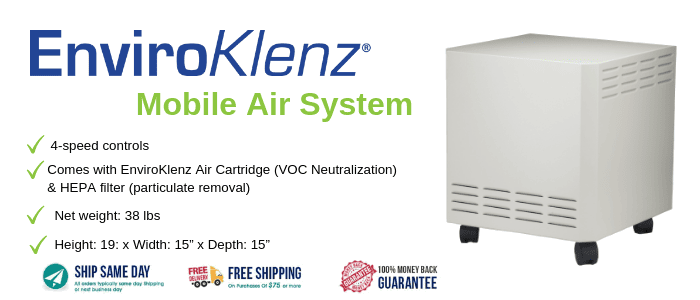
The EnviroKlenz Mobile Air System is your solution to removing VOCs and chemical pollutants from your indoor environment. With the use of a hospital-grade HEPA filter and an effective earth mineral technology air cartridge, this two-stage filtration is perfect to place in your indoor space to mitigate potential hazards to your health. Whether you have chemical sensitivities, allergies, or are just looking to improve your indoor air quality, the EnviroKlenz Mobile Air System is your answer!
- Simple and Easy to Set-Up, with Minimal Maintenance
- Replace Air Cartridge every 4 to 6 Months
- HEPA Filter Replaced Every Two Years
- Quiet Operation, 4-Speed Motor
- No Chemical Odors Released!
We are confident that our EnviroKlenz Technology will drastically reduce the odors in your home, if it doesn’t live up to your expectations, we will issue a full refund within 30 days of your purchase!
Click below to buy NOW!
